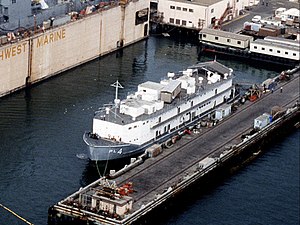 USS APL-4
| |
| Class overview | |
|---|---|
| Name | APL-2 class |
| Builders | |
| Operators | |
| Preceded by | Edmund B. Alexander class |
| Succeeded by | APL-17 class |
| Built | 1943-1945 |
| In commission | 1944-1946 |
| Planned | 15 |
| Completed | 12 |
| Cancelled | 3 |
| Active | 4 |
| Retired | 8 |
| General characteristics | |
| Type | Barracks ship |
| Displacement |
|
| Length | 260 ft 0 in (79.25 m) |
| Beam | 49 ft 2 in (14.99 m) |
| Draft | 8 ft 6 in (2.59 m) |
| Installed power | 100kW 450 AC |
| Propulsion | 3 × Diesel generators |
| Capacity |
|
| Complement |
|
| Armament | 4 × Oerlikon 20 mm cannons |
The APL-2-class barracks ship was a class of barracks ships of the United States Navy after the Second World War, in the late 1940s.[1]
Development[edit]
Twelve ships were built during World War II with 3 cancelled.[2] APL-12 and APL-13 were intentionally destroyed after being grounded by Typhoon Louise at Okinawa, by demolition charges, in February 1946.[3][4] Franklin D. Roosevelt approved the construction of tenders and repair ships in May 1943, it was then recommended by the Auxiliary Vessels Board on 11 June later that year, the construction of barracks ships.[1]
The class consists of barges with a two-story barracks built on top instead of the a warehouse design, and they had an auxiliary vessel designation of "A". Moreover, on their top deck, 4 Oerlikon 20 mm cannons were placed together with 2 gun and their platforms on each side of the ship.[1] The guns were later removed after being put into the reserve fleet in 1946.
Since 2011, only 4 ships have been in service at Naval Station San Diego.[1]
Ships of class[edit]
| APL-2-class barracks ship[2] | ||||||
|---|---|---|---|---|---|---|
| Name | Builders | Laid down | Launched | Commissioned | Decommissioned | Fate |
| APL-2 | Puget Sound Navy Yard | 12 May 1944 | 6 July 1944 | 25 May 1945 | - | CincPacFlt Berthing and Messing Program and is berthed at San Diego[5] |
| APL-3 | 31 May 1944 | 3 August 1944 | 30 July 1945 | - | Scrapped in 1974 | |
| APL-4 | 27 May 1944 | 3 August 1944 | 21 September 1945 | - | CincPacFlt Berthing and Messing Program and is berthed at San Diego | |
| APL-5 | 8 July 1944 | 14 November 1944 | 5 November 1945 | - | CincPacFlt Berthing and Messing Program and is berthed at San Diego | |
| APL-6 | 5 August 1944 | 12 February 1945 | Cancelled on 27 August 1945, completed as barge CROWN No.2 | |||
| APL-7 | 5 August 1944 | 12 February 1945 | Cancelled on 27 August 1945, completed as barge CROWN No.1 | |||
| APL-8 | Nashville Bridge Co. | 21 March 1944 | 5 June 1944 | 6 October 1944 | - | Sold to commercial service as merchant barge MLC-261 (ON 580686), 1974[6] |
| APL-9 | 5 May 1944 | 21 July 1944 | 24 November 1944 | - | Sold to commercial service as merchant barge MLC-260 (ON 581255), 1974[6] | |
| APL-10 | 12 July 1944 | 19 September 1944 | 6 January 1945 | - | Sold to commercial service as merchant barge MLC-263 (ON 561018), 1974[6] | |
| APL-11 | Boston Navy Yard | 5 August 1944 | 4 September 1944 | 10 October 1944 | - | Sunk as target by ComNavAirPac, 18 March 1974 |
| APL-12 | 5 August 1944 | 4 September 1944 | 24 October 1944 | - | Destroyed on 26 January 1946 | |
| APL-13 | 5 September 1944 | 12 October 1944 | 20 November 1944 | 23 November 1945 | Destroyed on 22 February 1946 | |
| APL-14 | Nashville Bridge Co. | 11 September 1944 | 17 January 1944 | 29 June 1944 | 3 January 1946 | Sold to Foreign Liquidation Committee (FLC), May 1947 |
| APL-15 | 29 October 1943 | 29 January 1944 | 1 August 1944 | - | CincPacFlt Berthing and Messing Program and is berthed at San Diego | |
| APL-16 | Cancelled on 22 October 1943 | |||||
See also[edit]
External links[edit]
- Photo gallery of Barracks ships of the US Navy at NavSource Naval History no nationality or prefix;
Citations[edit]
- ^ a b c d "APL-2 Class". www.shipscribe.com. Retrieved 19 January 2022.
- ^ a b "Barracks Ships and Barges (APB, APL)". shipbuildinghistory. 5 August 2020. Archived from the original on 26 February 2018. Retrieved 19 January 2022.
- ^ "Non Self-propelled Barracks Ship (APL)". www.navsource.org. Retrieved 19 January 2022.
- ^ "Non Self-propelled Barracks Ship (APL)". www.navsource.org. Retrieved 19 January 2022.
- ^ "APL-2 - Google Search". www.google.com. Retrieved 19 January 2022.
- ^ a b c Merchant Vessels of the United States. Vol. 2. U.S. Coast Guard. 1976. p. 2013.